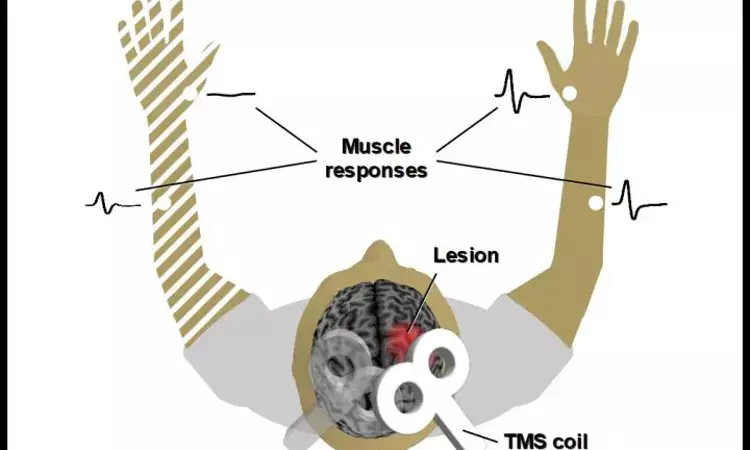- Home
- Medical news & Guidelines
- Anesthesiology
- Cardiology and CTVS
- Critical Care
- Dentistry
- Dermatology
- Diabetes and Endocrinology
- ENT
- Gastroenterology
- Medicine
- Nephrology
- Neurology
- Obstretics-Gynaecology
- Oncology
- Ophthalmology
- Orthopaedics
- Pediatrics-Neonatology
- Psychiatry
- Pulmonology
- Radiology
- Surgery
- Urology
- Laboratory Medicine
- Diet
- Nursing
- Paramedical
- Physiotherapy
- Health news
- Fact Check
- Bone Health Fact Check
- Brain Health Fact Check
- Cancer Related Fact Check
- Child Care Fact Check
- Dental and oral health fact check
- Diabetes and metabolic health fact check
- Diet and Nutrition Fact Check
- Eye and ENT Care Fact Check
- Fitness fact check
- Gut health fact check
- Heart health fact check
- Kidney health fact check
- Medical education fact check
- Men's health fact check
- Respiratory fact check
- Skin and hair care fact check
- Vaccine and Immunization fact check
- Women's health fact check
- AYUSH
- State News
- Andaman and Nicobar Islands
- Andhra Pradesh
- Arunachal Pradesh
- Assam
- Bihar
- Chandigarh
- Chattisgarh
- Dadra and Nagar Haveli
- Daman and Diu
- Delhi
- Goa
- Gujarat
- Haryana
- Himachal Pradesh
- Jammu & Kashmir
- Jharkhand
- Karnataka
- Kerala
- Ladakh
- Lakshadweep
- Madhya Pradesh
- Maharashtra
- Manipur
- Meghalaya
- Mizoram
- Nagaland
- Odisha
- Puducherry
- Punjab
- Rajasthan
- Sikkim
- Tamil Nadu
- Telangana
- Tripura
- Uttar Pradesh
- Uttrakhand
- West Bengal
- Medical Education
- Industry
Structural integrity of corticospinal tract best predictor for upper limb motor recovery

CAPTION
Stroke Popular Figure
CREDIT
M.Nzarova et al.
USAGE RESTRICTIONS
None
A team of scientists, with the first author from the HSE University, were investigating which factors are the most important for the upper limb motor recovery after a stroke. The study is published in Stroke, the world's leading journal for cerebrovascular pathology.
A stroke occurs when there is a blockage or rupture of a blood vessel feeding the brain. About 400,000 stroke cases are registered in Russia annually. Stroke is a disease, which occurs mostly in older ages but not only, for instance in Russia every 7th stroke happens in young people. Today there are more than 1.5 million people living in Russia who are in need of motor, speech, or cognitive rehabilitation due to stroke. The impairment in the upper limb is the most common and one of the most challenging for rehabilitation.
The extent to which the brain is damaged and movements are impaired after a stroke varies greatly among patients. How effectively a patient will regain his/her functions after a stroke depends both on the severity of the damage and the adequacy of the rehabilitation interventions. Assessment can be conducted using functional and structural approaches of brain imaging.
The published article is dedicated to a study of the relationship between the degree of movement recovery in the upper limb and the structural and functional state of the motor system, assessed using methods of transcranial magnetic stimulation (TMS) and magnetic resonance imaging (MRI). The study included 35 patients of young and middle age (in average 47 years old), who had a stroke more than six months prior to the study. The patients were divided into three groups depending on the level to which they regained movement in their upper limb: good, moderate, and bad.
The study showed that the structural integrity of the corticospinal tract assessed using structural MRI is the best predictor for the upper limb motor recovery. At the same time, the assessment of the state of the unaffected cerebral hemisphere and the integrity of the connections between the hemispheres did not have an additional value for classification when data on the integrity of the corticospinal tract were available.
The corticospinal tract is a pathway that connects the cerebral cortex with the spinal cord, allowing voluntary limb movement.
In addition, the study showed that the methods of MRI and TMS are equally effective for assessing the condition of the corticospinal tract in patients in chronic phase after stroke and can be used interchangeably when it is necessary to select a group of patients with low levels of recovery.
'However, it is important to consider that when assessing the motor system using TMS, it is necessary to study the evoked motor responses in several muscles of the upper limb. This makes it possible to reduce the number of false negative results-cases in which muscle responses to stimulation were not found, although the corticospinal tract was partially preserved,' says Maria Nazarova, research fellow at the Institute for Cognitive Neurosciences of HSE University.
The findings of the study can be used both to better understand the processes of recovery after a stroke and to plan individual motor rehabilitation in stroke survivors.
https://www.ahajournals.org/doi/10.1161/STROKEAHA.119.028832
Hina Zahid Joined Medical Dialogue in 2017 with a passion to work as a Reporter. She coordinates with various national and international journals and association and covers all the stories related to Medical guidelines, Medical Journals, rare medical surgeries as well as all the updates in the medical field. Email: editorial@medicaldialogues.in. Contact no. 011-43720751
Dr Kamal Kant Kohli-MBBS, DTCD- a chest specialist with more than 30 years of practice and a flair for writing clinical articles, Dr Kamal Kant Kohli joined Medical Dialogues as a Chief Editor of Medical News. Besides writing articles, as an editor, he proofreads and verifies all the medical content published on Medical Dialogues including those coming from journals, studies,medical conferences,guidelines etc. Email: drkohli@medicaldialogues.in. Contact no. 011-43720751


